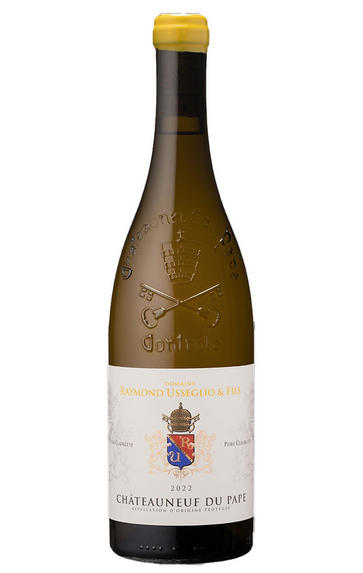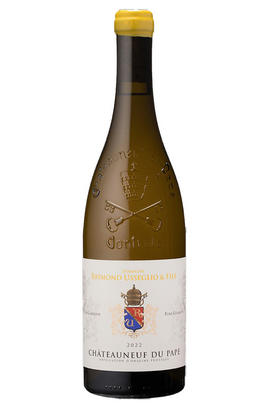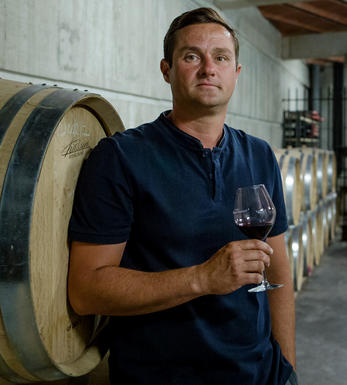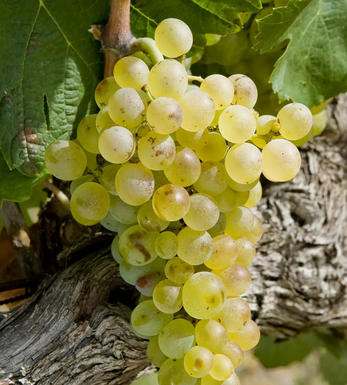
2022 Châteauneuf-du-Pape Blanc, Pure Clairette, Domaine Raymond Usseglio & Fils, Rhône

Critics reviews
Fermented in stainless steel and aged in concrete, Usseglio's 2022 Chateauneuf du Pape Blanc now includes five grape varieties: Grenache Blanc, Clairette, Roussanne and smaller amounts of Bourboulenc and Picardan. Subtle pear and nectarine aromas greet the nose, while the palate is medium to full-bodied, round and rich, loaded with fruit, then finishes long and zesty, with a hint of bitterness.
In 2021, Usseglio said, "We were lucky to not get frosted—only five out of 25 hectares were affected." Of course, he and his pickers had to dodge the same raindrops as everyone else during harvest, but his 2021s have turned out really well. In 2022, he said, "We had a good winter, then it was very dry, with small berries. With the coolish nights, the vines didn't stop—we already had finesse at the end of August. The ferments went fast, malolactic was quick [and] the wines are accessible early, like 2007."
If the wines really turn out like 2007, the 2022 vintage could be one for the ages—and not just at this domaine.
Drink 2023 - 2030
Joe Czerwinski, Wine Advocate (September 2023)
The colour of this is deep straw with a striking pink tinge. A powerful and ripe dry white with a rich, almost oily texture, but also a lot of pink grapefruit freshness. The little hint of bitterness at the finish really accentuates the minerality. Made from 50% of the white version of clairette and 50% of clairette rose grown on sandy soil with a northern exposure. Matured in a mix of demi-muids and larger Stockinger barrels. From biodynamically grown grapes with Demeter certification.
Drink or hold
Stuart Pigott, JamesSuckling.com (May 2023)
Equal parts Clairette and Clairette Rose, the 2022 Châteauneuf Du Pape Pure Clairette showed beautifully, with a layered, medium to full-bodied, pure profile as well as classy orchard fruits (pear, golden apple), vanilla cream, spice, and hints of toasted green almonds. It's pure, focused, and nicely concentrated, with integrated acidity. This cuvée is brought up in a mix of foudre (60%) and demi-muids (40%).
Jeb Dunnuck, JebDunnuck.com (October 2023)
The 2022 Châteauneuf-du-Pape Blanc Pure Clairette is an equal blend of Clairette and the rare Clairette Rose. Swirling the glass unveils precise aromas of orange blossom, white peach, apricot, mango, melon, fresh ginger, discreet vanilla and a splash of verbena tea. Full-bodied, concentrated and layered, the finish is persistent. It will provide sheer drinking pleasure over the next couple of years.
Drink 2023 - 2030
Nicolas Greinacher, Vinous.com (June 2023)
About this WINE

Domaine Raymond Usseglio
This third-generation family domaine, of Italian origin, is today run by Raymond’s son, Stéphane Usseglio. The estate counts 24-hectares in Châteauneuf-du-Pape, all of which have been managed biodynamically since 2011. Their vineyards are divided equally between the galet-strewn parcels around Orange, the sandy soils of Courthézon and the alluvial, clay soils of the Crau plateau and the village of Bédarrides. Stéphane continues to innovate, using small, new oak barrels alongside the traditional foudres, as well as experimenting with concrete and terracotta amphorae of varying shapes and sizes. These winemaking techniques enhance the characteristics of each grape variety, carefully highlighting the particularities of each.
Stéphane’s 2021 wines are a great success, albeit 20-25% down in volume against their average yield. The wines show their trademark power and structure; but as we’ve seen with other producers, they also have lower levels of alcohol and higher acidity than the last two vintages. While this freshness makes them more approachable in youth than in some years, their structure will ensure they are nonetheless worthy of cellar ageing. They are wines to return to throughout their ageing process.

Châteauneuf-du-Pape
The most celebrated village of the Southern Rhône, Châteauneuf-du-Pape is the birthplace of the now indispensable French Appellation d’Origine Contrôlée system – imperfect though it may be. Compared to the Northern Rhône, the vineyards here are relatively flat and often feature the iconic galet pebbles – the precise benefits of which are a source of much debate. Minimum alcohol levels required by the AOC are the highest in France, but at 12.5% it is well below the natural generosity of Grenache, which only achieves its full aromatic potential when it is fully ripe and laden with the resultant high sugars. Syrah and Mourvèdre contribute the other defining elements in the blend, adding pepper, savoury spice and structure to the decadent Grenache. There are a further 10 permitted red grape varieties which can be used to adjust the “seasoning”. Of the five white varieties permitted, it is Grenache Noir’s sibling – predictably perhaps – Grenache Blanc, which dominates, though Roussanne shows a great deal of promise when handled well, notably at Château de Beaucastel.

Clairette
Clairette is a white grape with a long history and is widely grown in various wine regions, particularly in France and other Mediterranean countries. It is known for producing wines with diverse styles, from dry to sweet and sparkling to still.
The variety is believed to have originated in the Rhône Valley, with historical references dating back to the 16th century. Nowadays, it is grown in several other Mediterranean regions, including Provence, Languedoc-Roussillon, Southern Rhône, and certain areas in Spain, Italy, and Algeria.
Clairette is a vigorous and high-yielding vine, making it relatively easy to grow in the vineyard. It prefers warm and sunny climates, which need plenty of sunlight to ripen fully. The grape clusters are medium-sized and compact.
The wines can vary in style, depending on the region and winemaking techniques. In some areas, it is used in blends to add acidity and structure, while in others, it can be the dominant grape in varietal wines.
The dry white wines typically exhibit delicate aromas of white flowers, citrus fruits, and sometimes hints of herbs. In certain regions, the variety is used to make sweet wines, either as a late-harvest style or as a component in fortified wines, such as the famous Muscat de Beaumes-de-Venise. Clairette is also used to produce sparkling wines, adding freshness and acidity to the blends.


Buying options
Add to wishlist
Description
This is a rare gem representing only 5% of Usseglio’s total production. Grapes are from the same plot as their Roussanne – on sandy soils with north exposure in the Bois Senechaux. A 50/50 blend of white and pink Clairette, this underwent natural malolactic fermentation. The nose has baking spices and mango notes while the palate delivers lemon, peach and melon flavours. The finish is long, clean and mouthcoating.
Drink 2024 - 2030
Berry Bros. & Rudd
wine at a glance
Delivery and quality guarantee